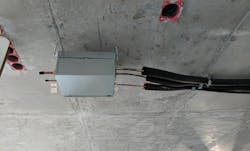Are Energy-Saving VRF Systems Worth the Money?
Variable refrigerant flow (VRF), a retrofit-friendly HVAC technology that’s still relatively young in the U.S. market, can reduce HVAC energy costs by 30 percent or more, according to the General Services Administration. The mature technology has a long history in Europe and Japan but has yet to corner the market in the U.S., in part because of its higher upfront cost compared to conventional HVAC systems.
However, VRF has the potential to deliver long-term savings, so the higher upfront cost may be worth it — especially for facilities with varied heating and cooling loads or organizations pursuing a green building certification. Discover the options for VRF systems and see how this energy-efficient technology could fit into your facility.
How VRF Systems Work
Conventional HVAC systems deliver heating or cooling with a constant flow of refrigerant. But VRF sends varied volumes of refrigerant to evaporators that control different spaces, meeting the needs and setpoints in each space, explains Jason Dodge, design engineer for John W. Danforth Company.
Each evaporator is individually controlled, which means that you can heat, cool or even simultaneously heat and cool multiple areas served by a single HVAC system depending on the type of VRF system you choose. Varying the amounts of refrigerant also allows you to keep people comfortable in spaces that have significantly different demands, Dodge says.
For example, a conference room, office space and a reception area all can be served by the same VRF system with different evaporators to control the varying needs of each area.
BUILDINGS Education
VRF: Best Practices for Integration and Operation
Variable refrigerant flow (VRF) systems are making inroads in the U.S. thanks to their energy-efficient operation and quick ROI. Could they be the HVAC solution you’ve been looking for?
Get this course on-demand and earn CE credits. Get started >>
“Scalability of the system is another pro,” Dodge says. “The connected capacity can range anywhere from 50 percent of the system size all the way up to 130 percent or more, depending on the manufacturer. That means you can connect an additional three tons of indoor evaporators to a 10-ton system since the load will change from one evaporator to another. Since we vary the amount of refrigerant to the evaporators that need it, others might need less or none at all.”
4 Types of VRF Systems
There are four key types of VRF systems, explains Scott Janssen, energy engineering manager for John W. Danforth Company:
1. Cooling-only systems
This type of VRF is the simplest in function and is “mostly comparable to traditional split systems,” Janssen notes, although “you can still take advantage of the part-load performance from inverter-driven compressors, which are going to be much more efficient.”
2. Heat pump style systems
This type of VRF performs similar to the fan coil systems often found in dormitories.
“Indoor units either heat or cool, but not simultaneously,” Janssen explains. “When the indoor units are in cooling mode, they act as evaporators. When they’re in heating mode, they act as condensers.”
3. Heat recovery systems
These systems can heat or cool different zones separately for maximum flexibility.
“You may want to consider it if you have one or more zones with loads or demands that are different from a majority of the other zones,” advises Janssen. “A branch controller can alternate your refrigerant piping connections with suction and discharge based on the mode of operation – heating or cooling.”
[From AHR Expo: Absorption Chillers: How Heat Drives Efficient Cooling]
For predominantly cooling with VRF, consider adding more heat exchangers to recover heat and repurpose it into space heating or domestic hot water.
4. Water source systems
These units can be located inside, unlike air source condensing units. Heat can be recovered or shared between multiple condensing systems that are connected to the same water loop, Janssen says. These are typically more energy-efficient than air source systems because water is more effective at carrying heat.
Connecting your water source VRF system to a geothermal field is also an option; it’s typically the most expensive VRF system but also the most efficient.
Considerations for Specifying VRF Systems
Is VRF a good solution for your facility? Janssen and Dodge recommend weighing your options against a few questions:
Why am I interested in VRF?
There are several ideal applications for VRF systems, Janssen explains. Organizations that place a high priority on energy efficiency may find that VRF satisfies their efficiency needs, especially for buildings in the process of earning LEED certification.
Buildings where zoning is important can benefit, especially if the zones are small spaces. VRF is also a good fit for sound-sensitive applications because the small indoor fans and inverter-driven compressors produce much less noise than traditional HVAC systems, Janssen says.
What is the best type of VRF system?
Finding the best option requires a thorough inventory of your building’s infrastructure and needs.
“How many evaporators should we use to meet the loads in the different spaces?” asks Dodge. “Is the building historic? Can we conceal equipment, piping and ductwork above the ceilings and walls? Is the electrical service large enough to support a VRF system? Is it acceptable to leave equipment, ductwork and piping exposed in occupied spaces? Indoor units will provide condensate that will need to be removed, so the slope of the piping, condensate pumps and area to terminate all must be considered.”
Help BUILDINGS Shape 2019!
What BUILDINGS resources are most valuable to you? What would you like to see us provide?
Please take our short (under 2 minutes) survey - just 5 short questions.
Thank you!
How much space will my system need?
“Do we have enough space to route large ductwork, or are we limited to smaller ducts and piping?” Dodge asks. “Is there space to conceal evaporators above the ceiling? Will we need to have them exposed? Do we need to use wall-hung equipment, floor-mounted, ceiling cassettes or ducted units?”
What is my load?
“Proper load calculations need to be completed to determine the correct amount of heating or cooling to condition each space,” says Dodge. “VRF systems typically carry a larger initial cost, so we want to make sure we’re not wasting money in selecting a system that’s too large.”
VRF systems can meet your thermal comfort and energy efficiency needs, but it’s crucial that they’re cost-effective for your unique situation.
Explore the technology’s lifetime costs and savings to see whether VRF can help you save money, keep your occupants comfortable and deliver your organization a high return on investment.
Check our coverage from AHR Expo 2019:
About the Author
Janelle Penny
Editor-in-Chief at BUILDINGS
Janelle Penny has been with BUILDINGS since 2010. She is a two-time FOLIO: Eddie award winner who aims to deliver practical, actionable content for building owners and facilities professionals.


